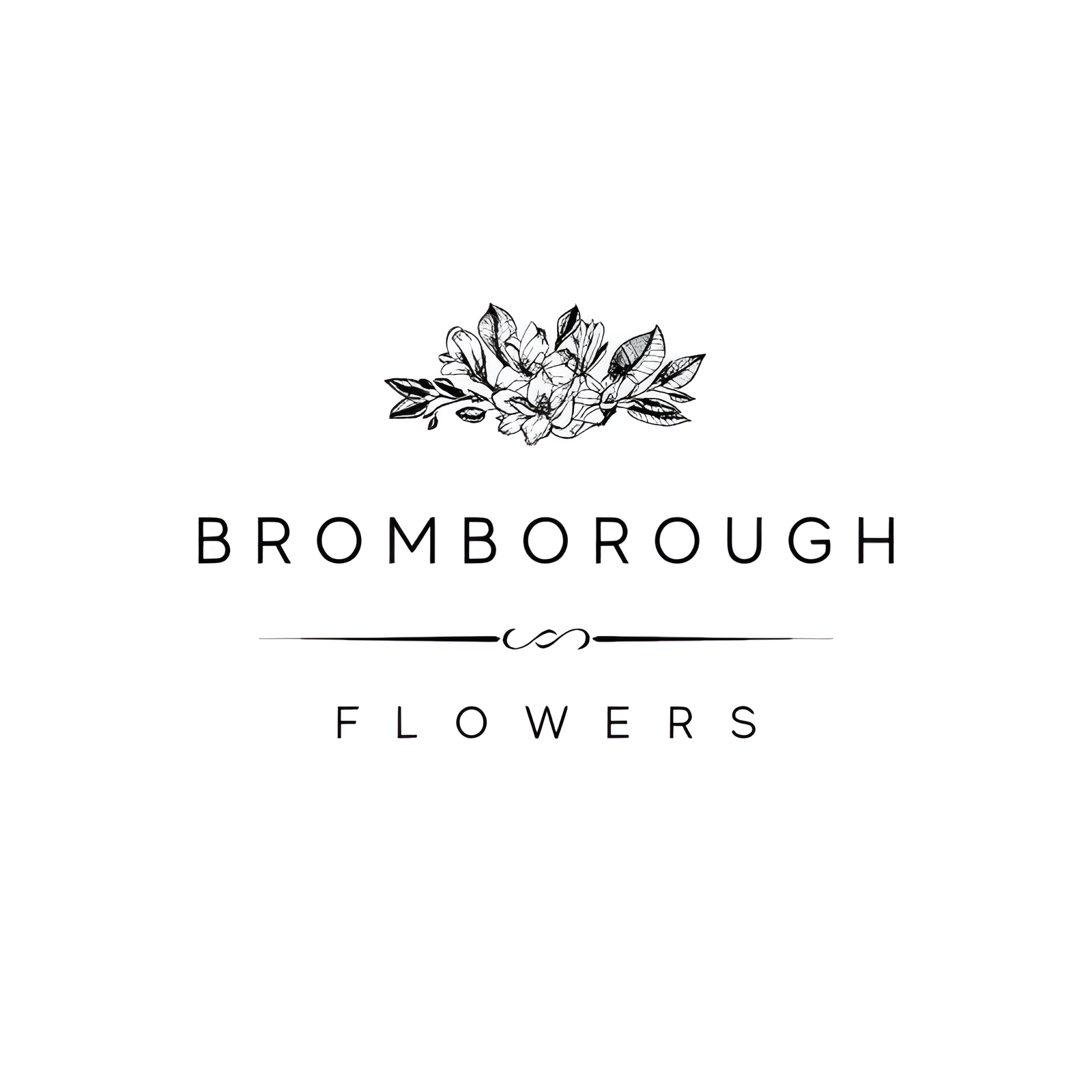The iris, known for its elegant and striking appearance, serves as an exceptional addition to wedding floral arrangements, offering more than just visual appeal. This flower, with its diverse color palette including purple, blue, white, and yellow, carries significant symbolic meanings such as wisdom and new beginnings, aligning seamlessly with the essence of matrimony. Beyond its aesthetic and symbolic value, the iris is also favored for its practicality, boasting a respectable vase life and year-round availability. As we explore the nuances of incorporating irises into wedding decor, you’ll discover how this versatile bloom can truly transform your special day.
Flower Overview
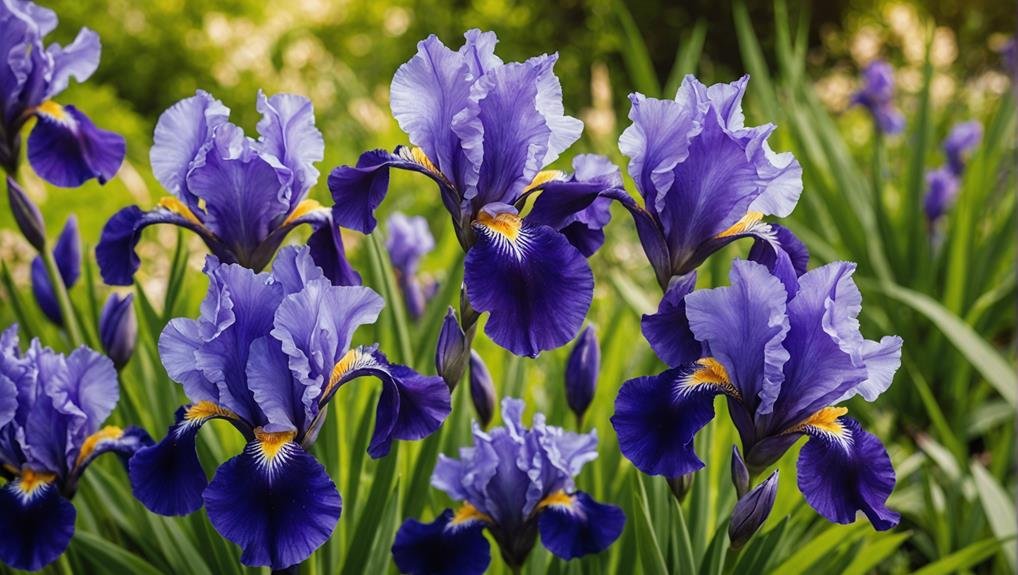
The iris, renowned for its vibrant shades and distinctive shape, is a favored choice for wedding flowers. This flower symbolizes new beginnings, wisdom, and compliments, making it particularly fitting for bridal arrangements.
Irises are available in a variety of colors, including purple, blue, white, and yellow, each carrying its own unique symbolism. The inclusion of bearded iris in wedding bouquets can elevate the aesthetic appeal, providing a stunning and sophisticated look.
Bearded irises are especially popular due to their striking appearance and rich color palette. They offer a versatile option for brides looking to create a memorable floral statement.
When planning to use irises for a wedding, it is important to take into account the quality, seasonality, and proper handling of the flowers. Purchasing wholesale iris can be a cost-effective strategy, but attention to these factors guarantees the flowers remain fresh and vibrant throughout the event.
Incorporating bearded irises into wedding decor not only enhances visual appeal but also adds a layer of symbolic meaning, aligning perfectly with the themes of new beginnings and wisdom. Therefore, irises continue to be a cherished choice for weddings, offering both beauty and significance.
Physical Description
Characterized by their vibrant purple petals and striking yellow throats, irises present a regal elegance that makes them a standout choice for wedding arrangements. The iris flowers are renowned for their unique form, where each stem typically holds 2.5 to 3.5 blooms. This abundance of flowers per stem adds a lush and visually striking element to bridal bouquets and other floral displays.
Irises have a vase life of 5 to 7 days, making them ideal for long-lasting wedding floral arrangements. Their durability guarantees that they maintain their beauty throughout the event, from the ceremony to the reception. Additionally, purple irises are available year-round, providing consistent accessibility for weddings regardless of the season.
The stems of iris flowers are usually bundled in groups of 18 to 24, which offers ample blooms for creating stunning and expansive bridal floral arrangements. This bundling not only facilitates easy handling but also secures that florists have enough flowers to work with for various decorative purposes.
The structural elegance and vibrant coloration of iris flowers make them a versatile and sophisticated choice for any wedding setting, enhancing the overall aesthetic with their regal charm.
Available Colour Varieties
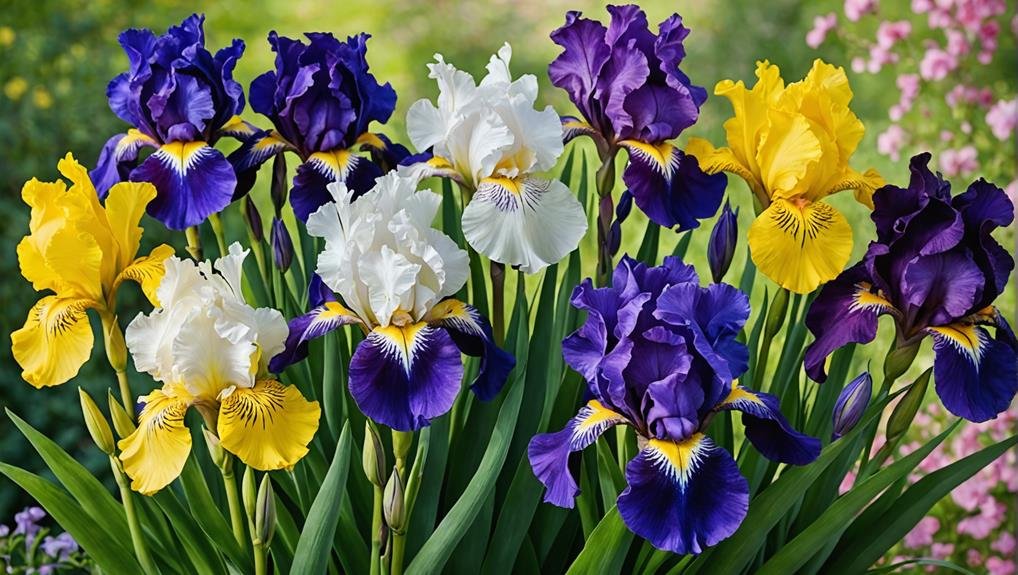
In addition to their iconic purple hue, iris flowers are celebrated for their extensive palette of colors, ranging from blue and white to yellow, pink, and orange. This broad spectrum allows for versatile floral arrangements, making irises a popular choice for weddings and special events. The rich color variety contributes notably to the depth and richness of bridal bouquets and wedding floral decor.
Understanding the different color varieties of iris flowers helps in selecting the perfect blooms to complement the wedding theme and color scheme. Each color can symbolize different meanings and emotions, adding a layer of sentiment to the occasion. For instance, blue irises often symbolize faith and hope, while white irises can represent purity and innocence. Yellow irises may convey passion, and pink irises often denote admiration.
Below is a table showcasing some of the popular color varieties of iris flowers:
| Color | Symbolism |
|---|---|
| Purple | Royalty, Wisdom |
| Blue | Faith, Hope |
| White | Purity, Innocence |
| Yellow | Passion |
| Pink | Admiration |
| Orange | Enthusiasm, Warmth |
Latin Name and Taxonomy
Iris, a genus within the Iridaceae family, encompasses up to 300 species, exhibiting remarkable morphological diversity. The Latin name for this genus is Iris, aptly reflecting its vibrant and varied species. The genus is renowned for its intricate classification system, which includes both bearded and beardless irises. This distinction is pivotal for horticulturists and botanists alike, as it influences cultivation practices and aesthetic applications.
The genus Iris is methodically divided into various subgenera and sections based on distinct morphological characteristics. This taxonomic structure aids in identifying and categorizing the extensive array of species within the genus. As of 2022, Plants of the World Online lists 310 accepted Iris species, underscoring the genus’s extensive diversity and the ongoing evolution of its taxonomy.
Introgressive hybridization is a notable phenomenon within the genus Iris, contributing significantly to its morphological diversity. This process involves the integration of genetic material from different species, leading to the emergence of new and varied forms. Such genetic fluidity not only enhances the aesthetic appeal of irises but also broadens their adaptability to different environments and uses, making them a versatile choice for wedding arrangements.
Geographical Origins
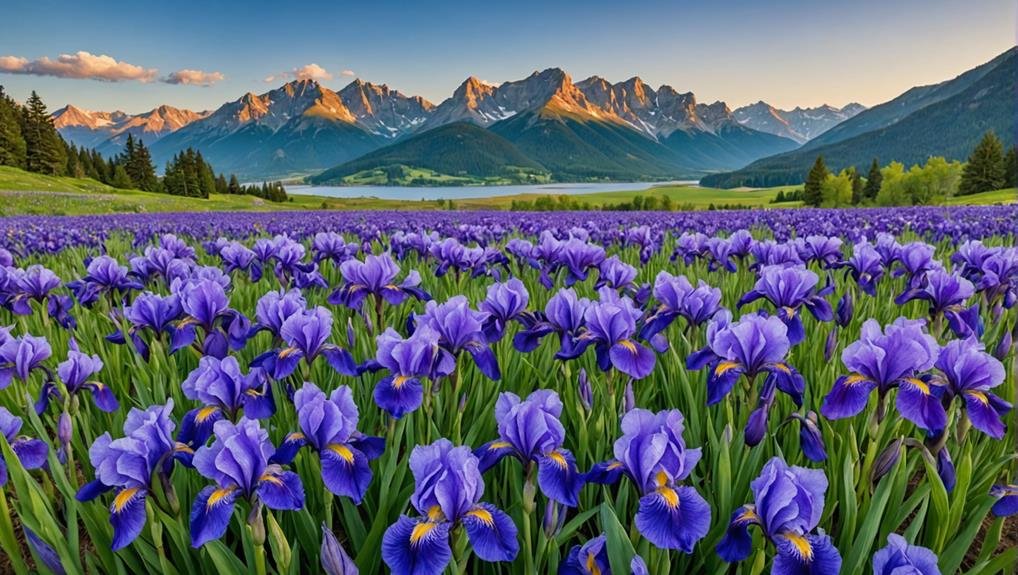
Spanning multiple continents, irises have established themselves in diverse regions including Europe, Asia, North America, and Africa. Their widespread presence is a proof of their adaptability and the rich tapestry of climates they can thrive in. For instance, Iris germanica, a species commonly associated with the elegance of wedding bouquets, is native to Southern Europe and Northern Africa. This specific variety has a storied connection to ancient Greece, where it was often depicted in art and mythology.
Meanwhile, Iris sibirica, known for its striking blue petals, hails from Eastern Europe and Western Asia. The climate of these regions, with their cold winters and warm summers, shapes the hardy nature of this iris species. Iris versicolor, or the blue flag iris, is indigenous to North America, flourishing in the wetlands and waterlogged areas.
| Iris Species | Native Regions |
|---|---|
| Iris germanica | Southern Europe, Northern Africa |
| Iris sibirica | Eastern Europe, Western Asia |
| Iris versicolor | North America |
The geographical origins of these irises reflect their evolutionary journey and the diverse environments they inhabit. Understanding these origins enriches the appreciation of irises, particularly in the context of their symbolic use in weddings.
Season Availability
Given the diverse origins of irises, their availability throughout the year further enhances their appeal for wedding arrangements. Irises are typically available year-round, making them a versatile choice for various wedding themes and settings. However, understanding the nuances of their season availability can help in planning the perfect floral decor.
The best quality irises are generally grown and sent to auction in large quantities during the spring season. This period offers an abundance of vibrant, fresh blooms, ideal for creating stunning wedding arrangements.
Conversely, in hot weather, the vase life of irises may be shorter, which is an essential consideration for summer weddings. Temperature plays a significant role in maintaining the freshness and longevity of these flowers.
During colder winter months, irises may not fully open, which could affect their visual impact in arrangements. Additionally, while blue-colored iris varieties are highly sought after for their unique hue, they may have limited availability, often making them a rare find for weddings.
Growing Conditions
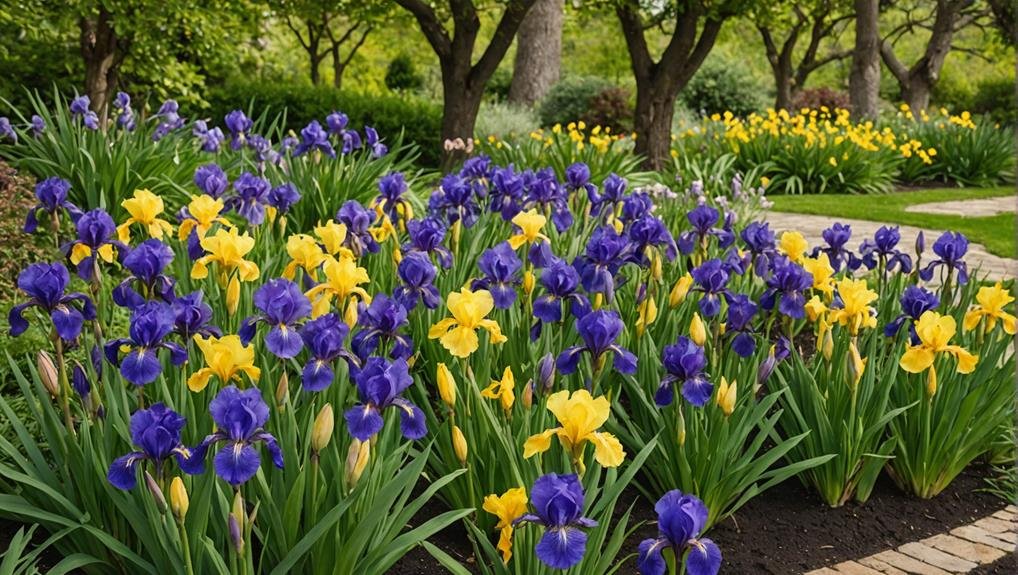
To nurture irises successfully, make certain they are planted in well-drained soil with full sunlight exposure. Irises flourish in conditions where the soil drains well to prevent root rot. The ideal soil pH for irises is slightly acidic to neutral, ranging from 6.0 to 7.0. Providing full sunlight for at least six hours a day promotes robust growth and vibrant blooms.
For best growth, consider the following guidelines:
- Planting Time: Plant irises in the autumn. This allows the roots to establish before the arrival of winter, ensuring a magnificent display of blooms in the spring.
- Watering Routine: Water irises deeply but infrequently. This encourages the development of strong root systems, which are essential for the plant’s overall health and resilience.
- Air Circulation: Ensure sufficient air circulation around the plants. Good airflow helps prevent common diseases such as leaf spot and root rot, keeping the irises healthy and vibrant.
- Container Use: If growing irises in containers, such as mason jars, make sure they have proper drainage holes. Overwatering can easily lead to root diseases in such confined spaces.
Cultural Significance
Exploring the cultural significance of the iris reveals a rich tapestry of meanings and traditions across different societies. In Greek mythology, the iris flower is deeply connected to the Greek goddess Iris, who served as a messenger between the gods and humanity. The flower’s name itself is derived from this divine figure, symbolizing communication and the conveyance of messages.
In Japanese culture, the iris is revered for its symbolic meanings of protection and good luck. Traditionally, it is believed that the iris can ward off evil spirits and bring prosperity, making it a common feature in various cultural ceremonies and home decorations.
Different colors of the iris also carry distinctive cultural meanings. For example, purple irises are often associated with royalty and wisdom, while blue irises represent hope and faith. These varied interpretations enrich the flower’s role in cultural rituals and personal celebrations.
The iris’s symbolic associations extend to wedding customs, where its meanings of faith, wisdom, and hope make it a poignant choice for bouquets and decorations. The flower’s diverse cultural symbolism underscores its enduring appeal and significance across different traditions and societies.
Typical Use in Weddings
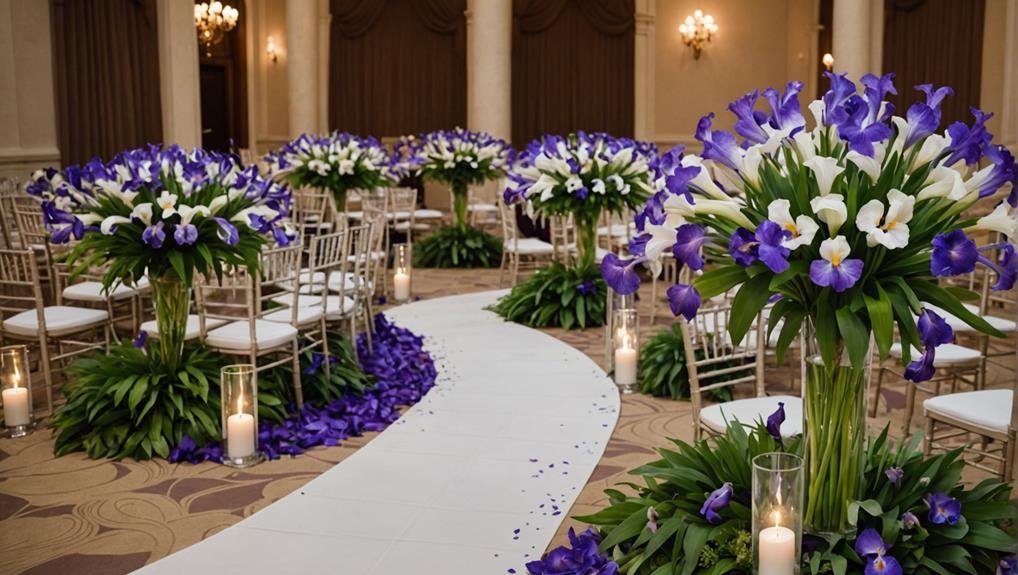
In weddings, irises are cherished for their elegance and vibrant colors, making them a popular choice for various floral arrangements. Their symbolism of faith, hope, wisdom, and new beginnings aligns beautifully with the essence of matrimony, bridging the gap between heaven and earth in a meaningful way.
Irises are versatile and can be seamlessly incorporated into multiple aspects of wedding decor, providing both aesthetic appeal and symbolic depth. Here are four common ways irises are used in weddings:
- Bridal Bouquets: Irises add a touch of sophistication and charm to bridal bouquets. Purple irises, in particular, stand out, offering a regal and elegant look.
- Centerpieces: Arranged in vases, irises make stunning centerpieces that bring a vibrant yet refined atmosphere to the wedding reception.
- Boutonnieres: Grooms and groomsmen can wear irises as boutonnieres, adding a cohesive floral element that ties together the wedding party’s attire.
- Corsages: Irises are also used in corsages for mothers of the bride and groom, as well as other special guests, enhancing their attire with a touch of grace.
With a vase life of 5-7 days, irises ensure that wedding arrangements remain fresh and beautiful throughout the celebration.
Alternative Flower Types
When planning wedding floral arrangements, couples often consider a variety of different flower types to complement or replace irises. Popular choices include lilies, roses, tulips, and peonies. These flowers offer elegance and can seamlessly blend with various wedding themes. Sunflowers, dahlias, hydrangeas, and orchids present vibrant options, adding a touch of uniqueness and color diversity to the arrangements. For those seeking something truly distinctive, unique blooms like protea, ranunculus, anemones, and succulents are excellent choices.
Seasonal flowers such as daisies, lilacs, marigolds, and daffodils can introduce a fresh and timely element to the floral design, aligning with the seasonal ambiance of the wedding. Mixing and matching different flower varieties guarantees a personalized and stunning wedding floral design that mirrors the couple’s individual tastes. Using watering cans as creative floral containers can further boost the thematic appeal, adding a rustic or whimsical touch to the decor.
Consider the following alternatives for your wedding flowers:
| Flower Type | Characteristics | Best Used For |
|---|---|---|
| Lilies | Elegant, fragrant | Bouquets, centerpieces |
| Sunflowers | Bright, cheerful | Rustic themes, outdoor venues |
| Protea | Unique, exotic | Focal points, statement pieces |
| Daisies | Simple, seasonal | Casual, garden weddings |
Incorporating these diverse flower types can lead to a memorable and visually appealing wedding day.
